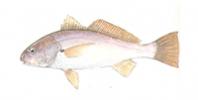Thank you for visiting the Seafood Selector. EDF is planning a new approach to providing information to consumers about good seafood choices. Please come back soon for updates.
Croaker

White croaker, © Amadeo Bachar
Recommended servings per month
| Contaminant | Men | Women | Kids 6-12 | Kids 0-5 | |
|---|---|---|---|---|---|
| Atlantic croaker (gillnet/trawl) | Mercury | 4+ | 4+ | 4+ | 4+ |
| Atlantic croaker (beach seine) | Mercury | 4+ | 4+ | 4+ | 4+ |
| White croaker | Mercury | 4+ | 4+ | 4+ | 4 |
| Whitemouth croaker | Mercury | 4+ | 4+ | 4+ | 4+ |
Eco details:
- Croakers are relatively fast-growing, making them resilient to fishing pressure.
- They are usually caught by gillnets, seines or bottom trawls. If used over sandy bottoms, these types of fishing gear do less environmental damage than those on hard bottoms.




